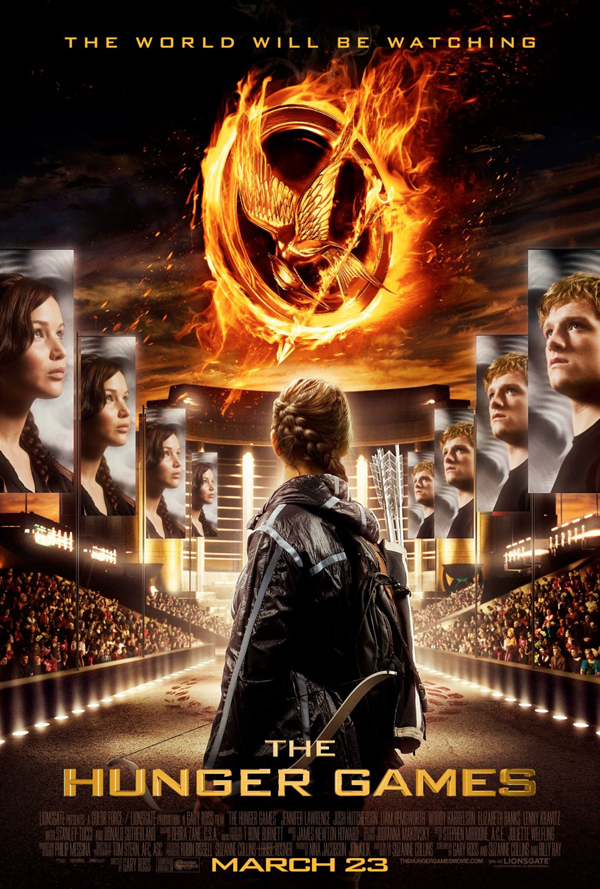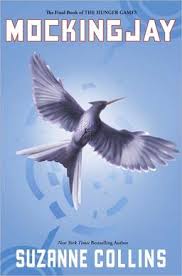With the news that a prequel to The Hunger Games by Suzanne Collins is upcoming, Monster Librarian brings forth a blast from the past, compiled by Dylan Kowalewski in 2012 just before the first movie was released, with reviews by Jim Cobb and Michele Lee.
The Hunger Games and Battle Royale
The Hunger Games by Suzanne Collins is an incredibly popular dystopian young adult series that has crossover appeal that very few other books have had, as both adults and teens love the books, and tomorrow The Hunger Games movie will open at theaters across the country.
Before Suzanne Collins had teens dueling to the death, there was another dystopian novel that had teens battling each other for survival, called Battle Royale. Battle Royale was written by Koushun Takami and was originally published in 1999. The book is set in an alternate world in Japan, where a totalitarian government, in order to terrorize the population, renders a school bus full of middle school students unconscious, only to relocate them on a small island where they are given random weapons and are forced to battle each other until there is only one survivor. It has also been made into a well-regarded, controversial film that has been compared to A Clockwork Orange with a not-so-wonderful sequel, and a manga series. Battle Royale is explicit in its violence, much more so than The Hunger Games, and that’s unexpected to many fans of Collins’ books who have heard that The Hunger Games is based on Battle Royale, but it has devoted fans of its own. Since the film was released, “battle royale” has taken on a new meaning– a fictional narrative or mode of entertainment (such as a video game) where a group of people are told to kill each other off until there is just one survivor.
So if you are a fan of The Hunger Games with a strong stomach, you might want to take a look at Battle Royale.
Speaking of The Hunger Games, Jim Cobb of Survival Weekly reviewed the first two books for us and Michele Lee reviewed the third and last one, Mockingjay. if you haven’t read the books yet now is the time to stop by your local library and pick up a copy!
The Hunger Games by Suzanne Collins
Scholastic Press, 2010
ISBN-13: 978-0545310581
Available: New and Used
In the not-so-far-off future, the United States has been decimated by disaster and war. It is now a country called Panem, and is broken into twelve districts. There were at one time thirteen districts, but one of them tried to rise up against the government, referred to as the Capitol, and was annihilated. Katniss, our main character, is from District 12, the poorest district. The reader may infer that this district is located in an area corresponding to Appalachia. Capitol citizens may enjoy fine food and drink, but those who live in District 12 subsist on dog, wild game, and grains.
Each year, two delegates (one boy, one girl, aged 8-18) are chosen by lottery from each district to compete in the Hunger Games. The Games are held in a different environment each year and are televised to the masses across the country. It is a battle to the death among the delegates. Think Lord of the Flies meets The Running Man.
During the current lottery, Katniss’ young sister, Prim, is chosen. As allowed by the rules, Katniss immediately volunteers to take her place. Katniss knows sending Prim to The Hunger Games is nothing but a death sentence. Her intention in volunteering has nothing to do with wanting to compete. Rather, she is trying to save her sister.
Katniss is a hunter who has spent years learning the ways of the woods– tracking, fishing, trapping, woodcraft. Her mother is an herbalist who has taught her what plants heal and how to use them. To feed her family, Katniss has taken down all manner of wild game… but can she kill another human being?
The characterization in this book is phenomenal. You feel the emotional conflict within Katniss every step of the way. The other characters have distinct personalities that are realistically portrayed. Some are sympathetic, others not so much. Readers find themselves rooting for certain characters and hoping others are taken down quickly.
The action sequences are well planned and executed. They are both exciting and brutal. These might be kids, but they are kids who want to win at any cost.
This is one of my favorite reads this year. It is written for the young adult crowd (grade 7 and up). The book is the first in a trilogy, with the third book set to hit bookstores in a few weeks.
Highly, highly recommended.
Reviewed by Jim Cobb
Catching Fire (Hunger Games Series #2)by Suzanne Collins
Scholastic Press; 1 edition, 2009
ISBN-13: 978-0439023498
Available: New and Used
Catching Fire is book two in the Hunger Games trilogy. It begins a short time after the end of the first book. Katniss and Peeta, our star-crossed lovers, have returned to District 12 victorious. They are given new homes for their families, as well as wealth and status. For a brief period, all is well. Katniss also learns of a rumor about District 13. All her life, she has been told District 13 was uninhabitable, due to being destroyed by the Capitol in a war whose end result was the creation of the Hunger Games. She is now told there are indeed people living in District 13, people who are working to overthrow the Capitol.
As part of their duties as Hunger Games victors, Katniss and Peeta are to tour the entire country of Panem, visiting each district in turn. On the day they are to depart, Katniss is confronted by President Snow. He is not at all happy with how the Hunger Games ended, and believes there is a resistance movement sweeping through the districts that has chosen Katniss as their symbol of rebellion. President Snow explains to Katniss she must prove to the entire country her defiance in the Hunger Games was not an act of rebellion but instead driven by her love of Peeta.
During their victory tour, Katniss witnesses firsthand both acts of defiance among the populace and the Capitol’s iron-fisted way of dealing with those acts.
The next Hunger Games is a Quarter Quell. This occurs every twenty-five years and allows the Capitol to introduce some sort of twist to the event. This time around, it is determined that the participants will be chosen from all living previous Hunger Games victors. Katniss and Peeta are headed right back into the arena, with every opponent being someone who has survived previous Hunger Games.
Twists and turns abound in this book, but it does suffer from what I call “middle book syndrome.” In almost every trilogy, the middle book is the weakest of the three. The first book is usually exciting in that there is a goodly amount of world-building. The reader learns who to root for and who to despise. The second book often is not much more than a lead up to a dazzling conclusion in the third volume.
In this particular case, Catching Fire does contribute to the overall story. It is well-written and the characters are fleshed out well. But the reader, knowing there is another book coming, might feel this book goes a bit slower than necessary. Certainly by the time the actual Hunger Games begin, the reader is almost out of patience.
Overall, the book is a good follow up to the first volume, but it does move slowly. Recommended for all those who loved the first Hunger Games book.
Reviewed by Jim Cobb
Ye gods, what a mule kick in the heart this book is. Katniss has seen the destruction of her town and most of the people she knew. She’s faced the Arena twice for the amusement of her world, and had to kill, and face her own death. Now she lives in the tunnels of District 13, being forced to become the star of the revolution.
Once again she’s trading her own well-being for that of others, but District 13’s president is determined to keep Katniss on a much tighter leash. War brings out a side of Gayle Katniss doesn’t like and Peeta, left behind in the Arena break out, is being tortured into playing Katniss’ opposite, moral booster for the Capitol and President Snow.
Even once rescued, Peeta has been so twisted by trackerjack venom and psychological reconditioning that he tries to kill Katniss more than once. Katniss, trying to deal with how very broken she is, has no real support, and at times it seems no one even cares about her, just The Mockingjay.
War isn’t prettied up at all for readers, which is a mixed blessing since there’s no real diluting of either battle, nor Katniss’ emotional trauma. Collins doesn’t even pretend that Katniss, or Peeta, or Gayle are valiant defenders of anything. They are people picking sides and fighting for what they feel is right, but in the process the tragedy they cause is just as real as the harm they endure spurring them to fight.
While it isn’t pretty, Mockingjay is an amazingly soulful story, sure to resonate with readers, teens and adults a like. Definitely a recommended read, but with a caveat for caution for anyone with trigger issues.
Reviewed by Michele Lee







Follow Us!